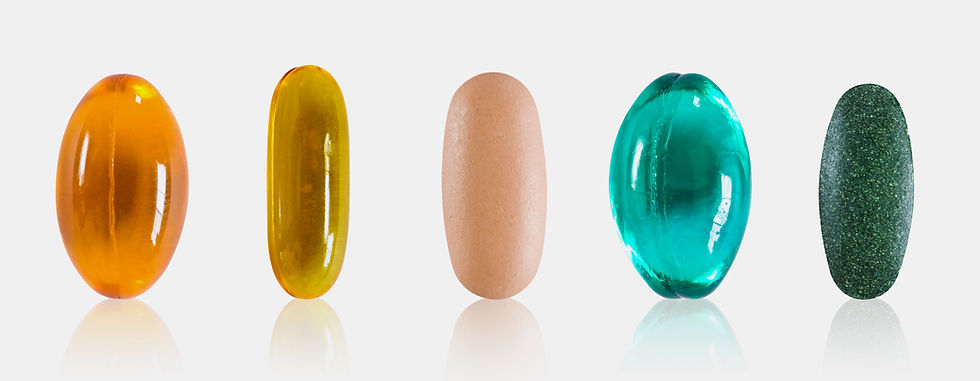The Truth About Lead In Food
- eric ritter
- 4 days ago
- 4 min read
If you’ve seen any recent Lead Safe Mama posts you’ve probably come across some pretty disturbing claims.The idea that the tiny amounts of lead found in virtually all foods will wreck your brain, or that we’re living in a toxic nightmare with no escape.
But the actual science is more nuanced. It’s still serious. But it also shows just how far we’ve come. Thanks to decades of public health efforts, dietary lead exposure in the U.S. has dropped massively. Here’s what the numbers actually say, how things have changed, and what it means for your IQ, blood pressure, and long-term health.
Honestly, it’s not even remotely as bad as some of these posts make it sound. Unfortunately with Tamara, when you read her writing, it’s really just her personal story being played out through her blogging. Whether it’s her version of events or part of her business model, she controls the narrative—and it’s mostly doom.
The massive decline in lead from food
The U.S. data
Direct long-term data on exactly how much lead people were eating in the U.S. decades ago is limited. Most of what we know comes from the FDA’s Total Diet Study (TDS), plus large blood lead surveys like NHANES that show the end result of exposure.
The FDA’s 2014–2016 TDS found that toddlers (1–3 years old) were consuming about 1.7 µg of lead per day on average, with high-end consumers around 2.6 µg/day FDA TDS.For a typical 20 kg child, that’s roughly 0.1–0.15 µg/kg/day. That is drastically lower than what would have happened in the 1970s and 80s, when leaded gasoline, lead solder in cans, and atmospheric fallout pushed exposure much higher.
We don’t have perfect U.S. intake data from back then, but we do have blood lead data:
Using Canada to fill in the missing data
Canada tracked direct dietary lead more systematically. Health Canada showed:
1981: ~0.8 µg/kg/day
1993–1999: down to ~0.2 µg/kg/day
2000+: around 0.1 µg/kg/day, with no big changes since Health Canada.
Given the shared industrial history (leaded gas, soldered cans, old plumbing), the U.S. almost certainly followed the same path. That means our dietary exposure has likely dropped by at least a factor of 8 since the early 1980s.
Similar patterns were documented in Europe, where lead intakes fell dramatically once lead solder was banned and leaded gas was phased out EFSA, UK TDS.
How much lead does it actually take to elevate blood lead levels?
This is where context matters. Based on WHO/JECFA data and toxicokinetic studies in Scottish children, about 0.1 µg/dL of blood lead rises for every 1 µg/day of dietary lead intake (it ranges from 0.05–0.16 depending on the study) WHO TRS 960.
So if a child eats 10 µg/day of lead from their food:
You’d expect roughly 0.5–1.6 µg/dL increase in their blood lead.
Given that U.S. kids today are typically consuming only 1.5–2 µg/day, it would take significantly more than their current diets—often 5 times higher intake—just to get a typical child up by 1 µg/dL.
What about IQ and blood pressure?
IQ
The WHO/JECFA 2010–2011 analysis (which pooled data from the famous Lanphear et al. studies) showed:
0.3 µg/kg/day is tied to about a 0.5 IQ point drop.
That’s 6 µg/day for a 20 kg child.
Today, kids in the U.S. are generally well below that level from food alone. This doesn’t mean there’s no impact, because there’s no known safe level. But it does show we’re nowhere near the crisis levels that would justify the kind of panic some people push.
Blood pressure in adults
For adults, WHO found each 1 µg/dL rise in blood lead bumps systolic BP by about 0.28 mmHg. To get that from diet alone would take roughly 80 µg/day, which is 4 to 8 times higher than most adults consume today.
Why there’s no more “safe weekly intake”
For decades, the WHO set “Provisional Tolerable Weekly Intakes” (PTWI) for lead:
1986: 50 µg/kg/week (~7 µg/kg/day)
1993: Cut to 25 µg/kg/week (~3.6 µg/kg/day) [WHO TRS 751, 837].
But by 2010, seeing effects at even lower levels, they withdrew the PTWI entirely. There’s simply no threshold they could declare truly “safe,” especially for kids WHO TRS 960.
The real story vs. fear-based content
This massive drop in dietary lead over the last 50 years is one of the biggest public health wins ever. The average American consumes a fraction of the lead they did in the 70s. That’s why blood lead levels are 10–20 times lower today.
But that also means most kids aren’t getting elevated blood lead levels from normal diets. The only way to truly eliminate dietary lead is to ensure food isn’t grown in soils contaminated by historic lead fallout—a near impossibility. It’s just a fact of life that we all consume some lead.
So the point isn’t panic. It’s targeted prevention. That’s why I developed FluoroSpec—to actually identify and remove the specific items that are big contributors, like certain imported ceramics or spices, without losing your mind over every crumb.
References
FDA. Total Diet Study Analytical Results. 2014–2016. https://www.fda.gov/food/total-diet-study/total-diet-study-analytical-results
CDC. National Blood Lead Reference Value and Trends. https://www.cdc.gov/nceh/lead/data/national.htm
EPA. Blood Lead Levels in Children: United States, 1971–2016. https://www.epa.gov/americaschildren/environmental-health
Health Canada. Final Human Health State of the Science Report on Lead. 2013. https://www.canada.ca/en/health-canada/services/environmental-workplace-health/reports-publications/environmental-contaminants/final-human-health-state-science-report-lead.html
EFSA Panel on Contaminants. Scientific Opinion on Lead in Food. EFSA Journal 2010;8(4):1570. https://efsa.onlinelibrary.wiley.com/doi/epdf/10.2903/j.efsa.2010.1570
Ysart G et al. UK Total Diet Study. Food Addit Contam. 2000. https://pubmed.ncbi.nlm.nih.gov/11093586/
WHO. Evaluation of Certain Food Additives and Contaminants: 73rd JECFA Report. WHO Technical Report Series 960, 2011. https://www.who.int/publications/i/item/9789241209601
Lanphear BP et al. Low-Level Environmental Lead Exposure and Children’s Intellectual Function. Environ Health Perspect. 2005. https://ehp.niehs.nih.gov/doi/10.1289/ehp.7688
WHO. Evaluation of Certain Food Additives and Contaminants: 30th JECFA Report. WHO TRS 751, 1987.
WHO. Evaluation of Certain Food Additives and Contaminants: 41st JECFA Report. WHO TRS 837, 1993.



Comments